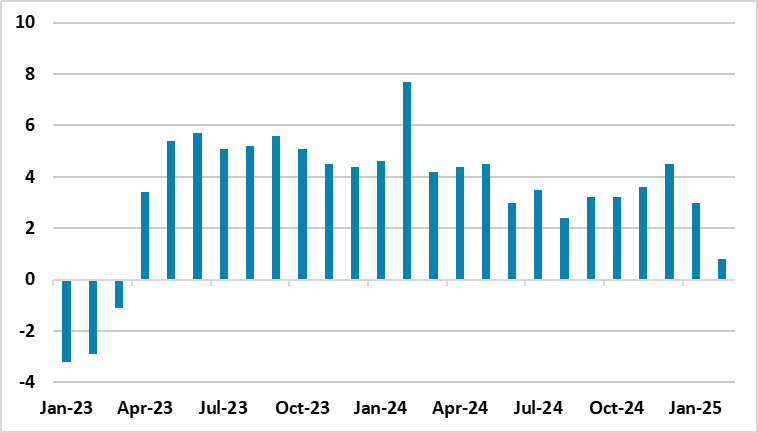Russia GDP Growth Loses Steam in the First Two Months of 2025
Bottom Line: According to the figures announced by the Ministry of Economic Development on April 3, Russia's GDP expanded by 0.8% YoY in February following a 3% YoY increase in January driven by military spending, higher wages and fiscal stimulus. The softening of growth figures demonstrates monetary tightening, sanctions, supply side constraints and higher price pressures remain restrictive. We envisage growth to hit 1.6% in 2025, which is significantly less than 2024 figure, as we foresee a ceasefire in Ukraine in 2025 that will likely lower Russia’s military spending and fiscal stimulus.
Figure 1: GDP Growth (%, Annual), January 2023 – February 2025

Source: Ministry of Economic Development
After Russian economy grew by a strong 4.1% YoY backed up by fiscal stimulus, strong military spending and consumption in 2024, Ministry of Economic Development announced ton April 3 that GDP expanded by 0.8% YoY in February following a 3% YoY increase in January.
According to the announcement, industrial production increased by 0.2% YoY in February after an increase of 2.2% YoY in January. Agricultural output surged by 1.4% YoY (+2.1%). The turnover of retail trade, catering and paid services to the public increased by 2.4% YoY in February, after a 5% YoY hike a month earlier. According to an assessment of the Ministry of Economic Development, the overall dynamics of key macroeconomic indicators in February were largely influenced by the calendar factor, as February 2025 had one fewer day than February 2024.
The main driver for the GDP growth remains the surge in military spending, supported by the improved consumer demand amid greater outlays on social support, higher wages and strong fiscal stimulus despite high interest rate, sanctions, and price pressures remain restrictive. We feel increased public spending in war-related industries and construction remain at unprecedented levels.
Despite the Central Bank of Russia (CBR) is forecasting 0.5%-1.5% GDP growth for 2025, and the government is expecting 2.0-2.5% growth, -which are significantly less than 2024 figure-, we envisage growth to hit 1.6% and 1.5% in 2025 and 2026, respectively, taking into account that we foresee a ceasefire will be likely declared in Ukraine in 2025 which will lower Russia’s military spending and fiscal stimulus.
In the meantime, the worst scenario for Russia will be stagflation (high inflation coupled with sluggish growth) before Ukraine war ends. Despite the economy remains overheated fueled by war spending, it is now suppressed by high inflation and interest rates coupled with supply-side constraints, and this should be closely followed by the CBR in the upcoming months.